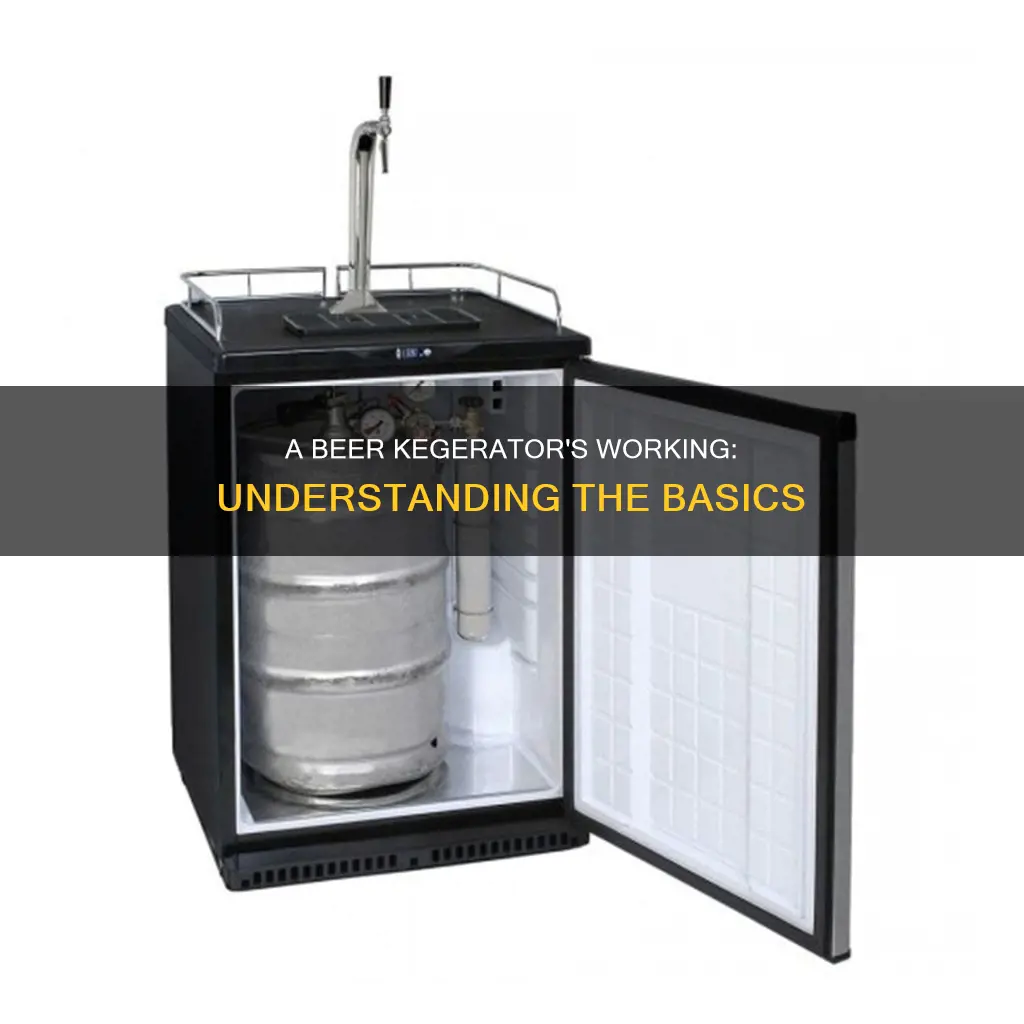
A kegerator is a refrigerator designed to store and dispense kegs of beer. It keeps the keg chilled and uses CO2 to pressurize and dispense the beer. The kegerator consists of a cooling system, a CO2 tank and regulator, and beer lines, fonts, and taps. The cooling system includes a compressor to keep the beer chilled, while the CO2 tank and regulator carbonate and dispense the beer. The beer lines transport it from the keg to the tap, where it is poured. Kegerators are available for both commercial and residential use and can be purchased, rented, or built. They are popular as they provide draught-beer enthusiasts with the ability to enjoy their favourite beer, freshly poured, at home.
| Characteristics | Values |
|---|---|
| Purpose | Dispense beer or other carbonated beverages |
| Mechanism | Uses CO2 to pressurize and dispense beverages from a keg |
| Suitability | Available for both commercial and residential use |
| Customization | Highly customizable with options for each component |
| Components | Cabinet, draft tower, faucet, faucet handle, drip tray, keg coupler, keg, CO2 regulator, CO2 tank, beer line, gas line, hose clamps |
| Temperature | 32-75 degrees Fahrenheit |
| Beverage Options | Beer, wine, cold brew coffee, kombucha, soda |
What You'll Learn
- Kegerators use CO2 to pressurise and dispense beer from a keg
- Kegerators are fridges designed to store and dispense kegs
- Kegerators can be used for commercial or residential use
- A kegerator conversion kit can be used to convert a standard fridge into a kegerator
- Kegerators can be used to dispense other carbonated beverages like wine, cold brew coffee, and kombucha

Kegerators use CO2 to pressurise and dispense beer from a keg
Kegerators are a blend of the words "keg" and "refrigerator". They are refrigerators designed to store and dispense kegs, usually of beer, by keeping them chilled. Kegerators use carbon dioxide (CO2) pressure to push beer out of the keg and into your glass via a tap.
A standard kegerator includes the following components:
- Cabinet: The refrigerated container that holds the keg and other components.
- Draft Tower: The tap tower sits on top of the cabinet and is where the beverage waits to be dispensed.
- Faucet: Where the beer is poured.
- Faucet Handle: The lever that is pulled to dispense beer.
- Drip Tray: Collects excess liquid that may drip down during pouring.
- Keg Coupler: Connects the gas and beer lines to the keg.
- Keg: Contains the beverage.
- CO2 Regulator: Allows the adjustment and maintenance of CO2 pressure for the perfect pour.
- CO2 Tank: Contains the CO2 gas that pushes the beverage out of the keg.
- Beer Line: The tube through which CO2 pushes the beverage from the coupler to the draft tower.
- Gas Line: The tube that allows CO2 to travel from the CO2 tank to the coupler.
- Hose Clamps: Ensure the gas and beer lines are well-connected.
Kegerators are available for both commercial and residential use and can be purchased or built. They are popular as they provide a pub-like experience, offering freshly poured draught beer with a frothy head.
Gas Blending: How Does a Beer Gas Blender Work?
You may want to see also

Kegerators are fridges designed to store and dispense kegs
Kegerators are available for both commercial and residential use, with the option to reconfigure a standard refrigerator into a kegerator using a conversion kit. They are designed to house one or more kegs, along with the dispensing system, and can be used for a variety of beverages, including beer, wine, cold brew coffee, and kombucha.
A standard kegerator includes the following components:
- Cabinet: The refrigerated container that holds all the components, including the keg.
- Draft Tower: The tap tower sits on top of the cabinet and is where the beverage is loaded and dispensed.
- Faucet: Where the beverage is poured. Faucets come in various styles, shapes, and finishes.
- Faucet Handle: Faucet handles come in different styles, shapes, and finishes, and can be customised.
- Drip Tray: Collects any excess liquid that may drip during pouring.
- Keg Coupler: Connects the gas and beer lines, tapping into the keg and allowing the beverage to flow.
- Keg: Contains the beverage to be dispensed.
- CO2 Regulator: Allows for the adjustment and maintenance of CO2 pressure for the perfect pour.
- CO2 Tank: Contains the gas that pushes the beverage out of the keg, giving it a fresh carbonated taste.
- Beer Line: The tube through which the beverage is pushed from the coupler to the beer tower.
- Gas Line: The tube through which CO2 travels to the coupler from the CO2 tank.
- Hose Clamps: Ensure that the gas and beer lines are securely connected.
Kegerators offer a range of benefits, including the ability to keep beer fresh for longer, cost savings compared to canned or bottled beer, and the convenience of having a pub-like experience in your home.
The Magical Math of 79 Beers: Age Subtraction Mystery
You may want to see also

Kegerators can be used for commercial or residential use
Kegerators are available for both commercial and residential use, and can be purchased pre-built or as conversion kits to modify an existing refrigerator. Commercial kegerators are designed for rigorous daily use in bars, restaurants, hotels, or offices, and are built to meet commercial quality standards. They are often built for either freestanding or built-in/undercounter installation, and can hold half-barrel (full-size), quarter-barrel (half-size or pony), or mini kegs (5-liter).
Residential kegerators are designed for at-home use and can be placed in home bars, kitchens, or outdoor areas. They are available in a variety of styles and with different features, such as auto defrost, CO2 tanks, and removable drip trays for easy cleaning. Residential kegerators can also be purchased as conversion kits to modify an existing refrigerator or freezer, which is a more economical option if you already have a suitable appliance. However, it is important to ensure that the refrigerator has enough space to accommodate a keg, as they typically require more room than a standard refrigerator.
Both commercial and residential kegerators can dispense a variety of beverages, including beer, wine, cold brew coffee, kombucha, and soda. The type of liquid being dispensed may require alterations to the dispensing system, such as using a CO2/nitrogen blend for wine and cold-brewed coffee to prevent corrosion. Additionally, different types of kegs require different keg couplers, so it is important to consider what you plan to serve when purchasing a kegerator.
Morning Beer: Should You Drink Before Work?
You may want to see also

A kegerator conversion kit can be used to convert a standard fridge into a kegerator
A kegerator is a refrigerator designed or modified to store and dispense kegs. It keeps the keg in a refrigerated environment and uses CO2 to pressurize and dispense beverages, keeping the contents fresh and carbonated for up to 60 days. While kegerators are available for both commercial and residential use, a standard refrigerator can often be reconfigured into a kegerator with a conversion kit.
Installing a conversion kit requires tools such as a socket wrench set, screwdriver, and a drill with a hole saw bit to modify the refrigerator. The CO2 tank, which is essential for dispensing beverages, can be installed inside the fridge if there is sufficient space. Alternatively, it can be placed outside the fridge and secured in place.
Kegerator conversion kits typically include the following components:
- Chrome Faucet (Beer Tap): Made of chrome-plated forged brass, the faucet connects to the shank and dispenses beer.
- Black Rubber Washers: These create a tight seal when connecting the beer line to the shank and keg coupler.
- Double Gauge CO2 Regulator: Allows you to measure and adjust the pressure going to the keg and check the amount of air in the CO2 tank.
- CO2 Tank: The CO2 cylinder contains high-strength aluminum alloy and provides the gas necessary to push the beverage out of the keg.
- Beer Line: A durable, food-grade vinyl tube connects the CO2 tank to the coupler and dispenses the beverage.
- Gas Line: This vinyl tube allows CO2 to travel from the CO2 tank to the coupler, pushing the beverage through the beer line.
- Hose Clamps: These clamps ensure that the gas and beer lines are securely connected. Thumb Screw Clamps are recommended as they can be easily adjusted without tools.
Miller Beer Text Rebates: How Do They Work?
You may want to see also

Kegerators can be used to dispense other carbonated beverages like wine, cold brew coffee, and kombucha
A kegerator is a machine that dispenses draft beer. However, they can also be used to dispense other carbonated beverages like cold brew coffee, kombucha, and wine. Kegerators have become a home bar essential because of their versatility.
Cold Brew Coffee Kegerators
Cold brew coffee kegerators are available in slim designs with single or dual tap options. EdgeStar, for example, offers a 24-inch-wide model with a digital display and deep chill feature. U-Line also offers a 15-inch-wide built-in or freestanding option with a single tap.
Kombucha Kegerators
Kombucha kegerators are specialised dispensers that keep kombucha cold and ready to drink. The Kegco Kombucha Kegerator KOM19S-1 is an example of a kombucha kegerator that can dispense fresh kombucha at home.
Wine Kegerators
Wine kegerators are a great way to save money and control the condition of how wine is served. Wine on tap is more cost-efficient and maintains its quality from the first glass to the last as it is not exposed to oxygen like bottled wine. Stainless steel liquid contact is imperative to prevent corrosion over time, which can affect the taste and quality of the wine.
Beer Chillers: How Do They Work?
You may want to see also
Frequently asked questions
A kegerator is a refrigerator designed to store and dispense kegs of beer. It keeps the keg chilled and uses CO2 to pressurise and dispense the beer.
A kegerator uses a compressor and cooling system to keep the keg chilled. It also uses a CO2 tank and regulator to carbonate the beer and maintain the right pressure to push it through the beer lines. The beer then flows through the lines and out of the tap when it's poured.
A kegerator typically includes temperature control, a CO2 regulator, taps and handles, and a drip tray to catch spills.







